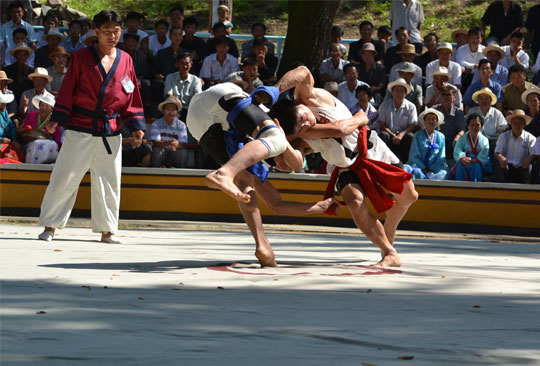Korean Ssirum, with a long history and tradition
Korean Ssirum (wrestling) is a national physical game which two opponents try to push another to the ground, using Satpa (a fabric strap used as a handle connecting the waist and leg).
It is a popular game that anyone can play anytime and anywhere.
The game finishes when a wrestler knocks the other down with diverse Ssirum tricks and it is announced to be a loser if any part over his ankles touches the ground.
The game is divided into Left Ssirum and Right Ssirum according to the position of Satpa on the legs. When the players do not use Satpa, it is called Mindung Ssirum (bare ssirum) or Negup Ssirum (limb ssirum). There is also a game of Standing Ssirum which does not allow players to bend their knees.
Ssirum is played all over the country, and especially Pyongyang took a leading place in its practice and transmission.
At present, in scenic places like Mt Taesong, Rungna Islet and Moran Hill, Ssirum rings are well furnished to play the games on folk days and holidays.
Originated from ancient times, Ssirum was played among the peasants at breaks of work and on holidays, especially after successful physical labour including rice transplanting, weeding and harvesting.
At breaks of work or in a family, the players are not strictly required to wear traditional costumes.
The custom of prizing the winner a bull that is earnestly needed in farming is a special awarding method unique to the Ssirum games.
Especially, the Grand Bull Prize National Ssirum Contest taking place on the occasion of Chusok (Harvest Moon Day) every year becomes an important occasion to carry forward the outstanding cultural tradition of the nation.
